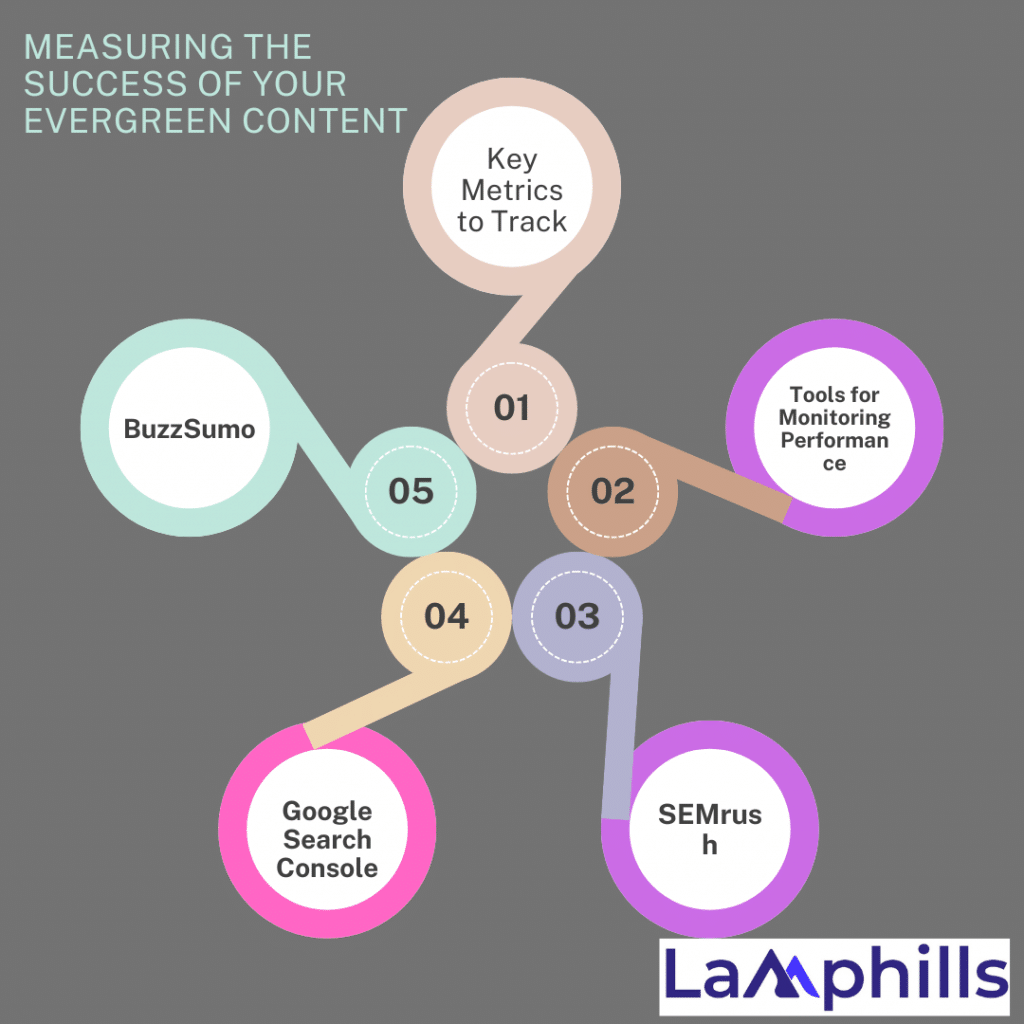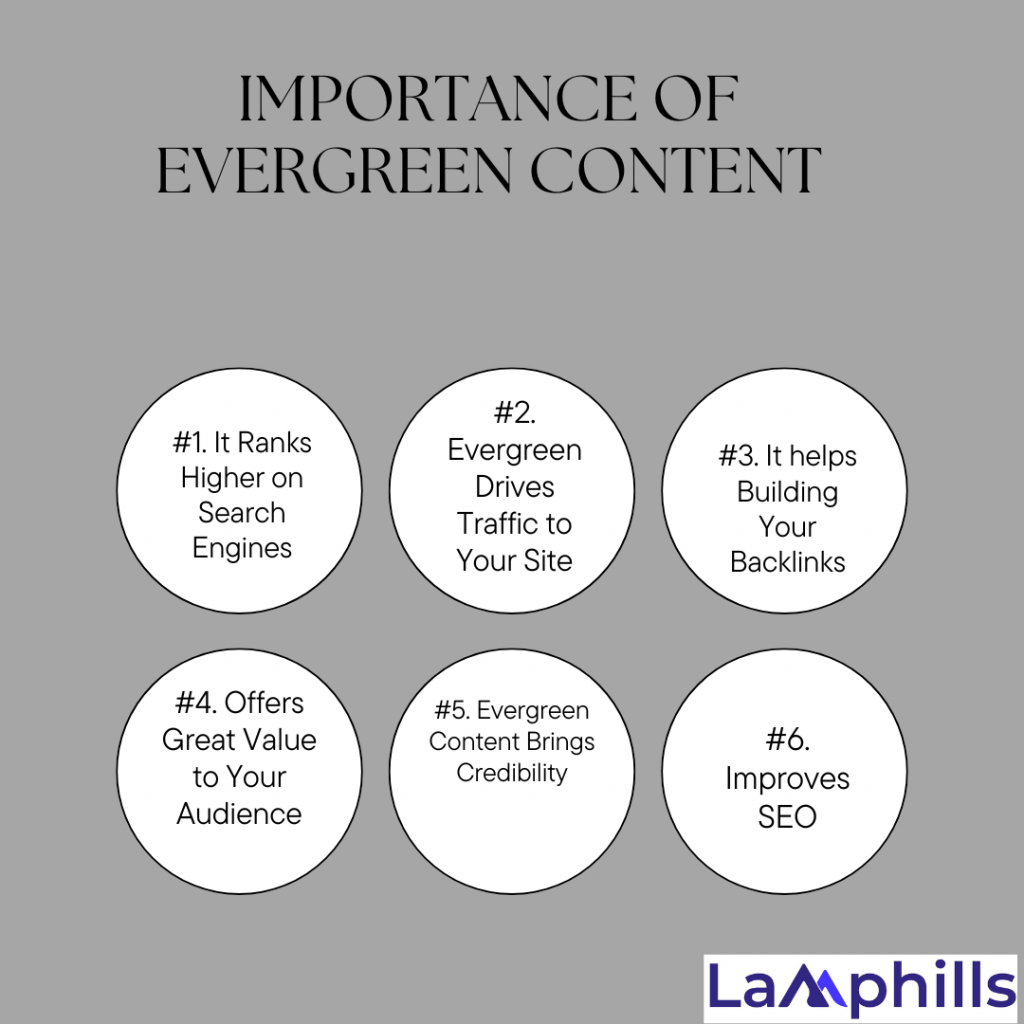If you’re involved in SEO, content marketing, or any other type of web marketing, you’ve most likely heard the term “evergreen content” and been told that your website requires it. Similar to investing, creating content that consistently drives traffic to your website or social media can yield compounding returns over time. Evergreen content refers to that content on your website, blog, or social media that has maintained interest over time. For a nutritionist, evergreen content could be “How to Start Eating Healthy”.
For content creators and anyone running their social media, being able to plan content that will always have interest from your audience is key to success. Although evergreen content is commonly associated with blog posts, it may be applied to a variety of aspects of your marketing strategy. So, what is evergreen marketing, and why is evergreen content beneficial to SEO? Today I’ll go over the fundamentals of evergreen content, how to develop evergreen content
Key Takeaways
- Evergreen content, by its nature, remains relevant and valuable over time, unlike trend-based articles that have a short lifespan. This type of content continues to attract traffic, engage readers, and provide consistent value long after its initial publication.
- Well-optimized evergreen content can rank high on search engines, driving consistent organic traffic. The article highlights that evergreen content’s long-lasting relevance makes it an essential component of a successful SEO strategy.
- Examples of evergreen content include how-to posts, guides, listicles, and Q&A articles. These formats are effective in addressing common pain points and questions, making them useful and relevant for readers over the long term.
- Regularly updating older evergreen content is crucial for maintaining its relevance and effectiveness. This includes adding new information, updating links, and refreshing SEO elements to ensure the content continues performing well and providing readers value.
What is Evergreen Content?

When I launched my first business blog, I felt like a kid in a candy store—both delighted and overwhelmed by the possibilities. I produced articles at a rapid rate, covering industry trends and news. But after a few months, I discovered a worrying trend: my traffic was as bad as the cloudy weather. One week I’d have a slew of guests, the next a trickle. That was when I realized the power of evergreen content. Unlike trend-based articles, which have a transitory appeal, evergreen content has the potential to keep readers coming back long after they are published. You could say that evergreen content is the “gift that keeps on giving.”
Evergreen content is search-optimized information that remains relevant and “fresh” for readers over time, as the term suggests. You may believe that all online material is sustainable; after all, a blog post does not simply disappear after being published, however, evergreen content is different. It remains relevant long after its published date, with search traffic increasing over time. It possesses three primary characteristics:
- Longevity: This content remains relevant and useful for years. For instance, a detailed guide on effective time management techniques is likely to be just as valuable in five years as it is today.
- Value: It provides consistent value to readers. Whether it’s a how-to guide, an industry insight, or a comprehensive FAQ, evergreen content addresses common pain points and questions.
- Searchability: Well-optimized evergreen content ranks high on search engines, driving consistent organic traffic.
So Why Is It Called “Evergreen”?
Even non-marketers will recognize the term “evergreen” because evergreen trees (often pine or fir) are commonly used to adorn homes for Christmas. The evergreen tree represents eternal life since it keeps its leaves throughout the seasons rather than dropping them. Evergreen material, like trees, is considered sustainable and long-lasting.
Perhaps you’re thinking, “Hey, wait a minute. “All online content is sustainable; articles and blog posts will never disappear.” When we term a piece of content as “evergreen” it means that it will continue to be relevant past its publication, so traffic grows over time.
To better clarify what kind of writing is considered “evergreen,” we can examine what types of pieces are specifically not evergreen.
What Evergreen Content is Not:
- News articles
- Statistics or numerical reports that are likely to change and go out of date
- Pieces about a specific holiday or season
- Articles focused on a current trend or pop culture fad
- Latest clothing and fashion trends
Evergreen web content has (almost) no expiration date and should sustain its value in the long run. For example, anything written about this year’s presidential race is not evergreen because it will become out of date in six months. Many terms related to that issue will wind up in the Google graveyard, never to be seen again.
Examples of Evergreen Content

Evergreen content can be adapted across various industries. As long as you have a clear idea of how you want this content to help your audience, you can create long-lasting content. Here are a few examples of evergreen content types any industry can use.
#1. How-to Posts
These articles guide readers through a process.
- “How to Grow Organic Traffic”
- “How to Find a Therapist”
- “How to Create a Website“
- “How to Start a Blog“
- “How to Build a Fence”
#2. Guides
The “Ultimate Guide” is one of the more popular types of evergreen content. Ultimate guides will solve a common question or problem by breaking it down into bite-sized, step-by-step explanations. This type of content breaks down complicated topics or processes.
- “A Guide to YouTube”
- “The Ultimate Grammar Guide”
- “Guide to a Healthy Pregnancy”
- “Guide to Bitcoin Investing”
#3. Listicles
A numbered list can make a concept more accessible.
- “10 Ways to Cope With Stress”
- “7 Ways to Reduce Pollution”
- “6 Examples of Renewable Resources”
- “8 Small Dog Breeds”
#4. Questions and Answers
We all have common questions that we are asked about our business, our products, or our industry. If you hear a certain question repeatedly, it’s a safe bet that people aren’t just asking you that question. They are probably Googling it as well. These posts answer a key question.
- “When Is the Best Time to Buy a Car?”
- “What Should I Know Before Buying a House?”
- “Where Can I Buy Stocks Online?”
Adding the year (“Best Vacation Spots in 2024“) or season (“Best Summertime Activities in New York”) to the title also limits how far your content can stretch. While these topics might still attract viewers after they’re published, they won’t be as evergreen as pieces that aren’t tied to a specific time.
#5. Case Studies/Testimonials
Customer stories are a great method of creating evergreen content and also getting social proof for your brand. For inspiration, check out our Case Studies page or Notion’s Customer Stories.
Proven Strategies for Writing Evergreen Content

Now that you know what evergreen content is and what it’s not, along with the types of formats that work best, here are some specific tips for writing evergreen content:
#1. Find Out Your Audience Wants
Evergreen content is focused on keywords. Choose which themes are important to your business or brand and how they can benefit your target audience. This is because understanding your audience is critical. So, use Google Trends and keyword research tools to determine what your target audience is looking for.
When I began focusing on evergreen content, I discovered that my readers were constantly looking for productivity advice, which led to my incredibly successful piece, “10 Productivity Hacks for Busy Professionals.”
- List some relevant industries and keywords (you can use a keyword tool like Ahrefs).
- Find out what problems your target audience has in common. You can do this by conducting interviews or asking right on your social media. Consider checking platforms like Quora and Reddit as well to find out what questions your audience is asking.
- Check your audience feedback and keywords against the search results using Google Trends.
Also, finding evergreen topics is all about staying away from time-sensitive topics and focusing on topics that are searched for consistently on Google.
Here’s how to find these topics:
- Go to Ahrefs’ Keywords Explorer
- Enter a relevant keyword
- Go to the Matching Terms report
If a topic is evergreen, it shouldn’t be on a declining trend. So you’ll want to look at the “trends” graph to see if a topic is gaining or losing popularity over time.
For example, the topic “bitcoin mining” has a high Traffic Potential but is declining in popularity:
#2. Choose the Right Keywords
I said earlier that longtail keywords may be ideal. Even the most durable evergreen piece is worthless if people aren’t searching for it, therefore conduct keyword research.
Prepare for SEO. Once you’ve chosen your keywords (one per article), remember to follow SEO best practices for on-page optimization. Add alt text to photos and include the keyword in the title, URL, and body copy – but don’t stuff it! To increase your SEO ranks, link related evergreen articles together.
#3. Don’t Write for The Experts
Sometimes you may feel compelled to create a paper demonstrating your knowledge of a certain subject, but this can be a costly mistake. Experts are unlikely to seek assistance; your target audience is mostly beginners, and you should create content for them.
Furthermore, avoid using highly technical language – Because the majority of your content is intended for beginners, complex, technical terminology may turn readers off, so stay with more straightforward rhetoric.
#4. Offer a Unique Point of View or Solution
If your content is identical to everyone else’s, there is no reason for the reader to choose yours over the others. They may simply select any post from the search results and be done with it. You want to make your content stand out. To accomplish so, you must provide a unique opinion or solution that other pieces of content do not have.
How do you do this? The greatest technique is to write about personal experiences. Everyone’s lived experience is unique, so you’ll be able to offer a perspective that others lack.
For example, when I wrote about creating an SEO content strategy, I didn’t provide a generic template. Instead, I wrote about it from our company’s personal experience in creating and implementing one.
#5. Narrow Your Topic
If you write about too broad a topic, your piece will be much longer, and more likely to lose the interest of beginner readers. Broad topics tend to be shorter keywords, or head terms, with more competition. Writing a broader piece also is more difficult for the writer. Simple, specific topics like “How to Throw a Roundhouse Kick” vs. “Guide to Powerful Kick Techniques” are more grabbing.
#6. Link Posts Together
If you’re doing a complete guide on a topic such as “Guide to Bike Care,” divide that broad topic into narrow, specific pieces such as “How to Oil Your Bike Brakes” and “How to Replace a Bike Tire,” and then link those articles together. This is great for SEO and lets readers solve a specific need while also guiding them to additional relevant articles.
#7. Update Older Evergreen Content
This checklist below will be of great help to you
You can also repurpose your existing blog content to generate more forgotten evergreen content. As part of your regular audit, update your postings, add new information, and re-post them. You can also delete the date stamp and re-post this video on your social media accounts. The date of the post is only relevant if it is a news piece.
Like interlinking, upgrading old information can improve search rankings. The process of updating content for relevancy and SEO is known as historical optimization.
#8. Refresh Your Blog Content Regularly
Huge miss alert: posting and forgetting. Why? Because keeping your evergreen blog content up-to-date can drive a new wave of visitors (and customers). While updating an old social media caption won’t do much, simple blog updates like new data, examples, tips, and updated links can make a world of difference.
At Later, we refresh blog posts monthly, quarterly, and annually — so we can share a balanced mix of evergreen and trendy content on social media. And if you have a YouTube strategy, you can audit old videos and film an updated version.
Measuring the Success of Your Evergreen Content

When I first began focusing on evergreen content, I was excited to see the benefits. But how can you assess the performance of information that is intended to last for years? It’s similar to establishing a garden: you need to keep an eye out for signs of growth and understand which clues indicate that your efforts are paying off. Here are five critical metrics to track,
#1. Key Metrics to Track
A. Organic Traffic
Evergreen content relies heavily on organic traffic. This refers to users who discover your material through search engines without the help of sponsored advertisements. When I launched my guide “Effective Networking Tips for Introverts,” I didn’t see a huge increase in traffic immediately away. However, as more people sought networking tips, the guide gradually climbed the search rankings and began to attract a steady stream of visitors.
To track organic traffic:
- Google Analytics: This free tool allows you to see how many visitors are coming to your site from search engines. Look for steady or increasing numbers over time as a positive sign.
B. Engagement Rates
Engagement rates include comments, shares, likes, and other interactions that show readers are not only consuming your content but also finding it valuable enough to engage with. For instance, my article “10 Productivity Hacks for Busy Professionals” garnered numerous comments and shares, leading to lively discussions and a sense of community among readers.
To track engagement rates:
- Social Media Analytics: Use analytics tools on platforms like Facebook, Twitter, and LinkedIn to monitor shares and comments.
- On-Site Analytics: Google Analytics can also show you metrics like average time on page and bounce rate, indicating how engaging your content is.
C. Backlinks and Domain Authority
Backlinks are links from other websites to your content. They are a strong indicator of authority and trust. The more high-quality sites that link to your content, the better it is for your SEO. I remember the first time a major industry blog linked to my “Ultimate Guide to Social Media Marketing.” Not only did it boost my traffic, but it also significantly improved my site’s domain authority.
To track backlinks and domain authority:
- Ahrefs: This tool provides detailed backlink profiles and domain authority scores.
- SEMrush: Another powerful tool for monitoring backlinks and overall site health.
D. Keyword Rankings
The performance of your content for specific keywords is a crucial metric. When I optimized my article on “SEO Best Practices,” I regularly checked how it ranked for targeted keywords. Watching it move up the search engine results page was like seeing your child excel in school—it was gratifying and a sign that my efforts were paying off.
To track keyword rankings:
- SEMrush: This tool can track the ranking of your site for specific keywords over time.
- Google Search Console: Provides insights into how your site performs in Google search results, including keyword rankings.
E. Conversion Rates
Finally, the effectiveness of your evergreen content should be consistent with your business objectives. Conversion rates demonstrate how successfully your content drives activities such as signing up for a subscription, downloading a resource, or making a transaction. For example, my article on the “Top 10 Tools for Small Businesses” featured links to an eBook I wrote. Tracking how many users downloaded the eBook provided me with valuable data into the success of my content.
To track conversion rates:
- Google Analytics: Set up goals to measure specific actions like form submissions, downloads, or purchases.
- CRM Tools: Customer relationship management tools can help you track leads and conversions tied to your content.
#2.Tools for Monitoring Performance
When I first began focusing on evergreen content, I immediately found that simply releasing the content was insufficient. I needed to know how it was functioning, what was working, and what needed to be improved. Consider establishing a garden—you wouldn’t simply put seeds and walk away. You regularly check on your plants, water them, and make sure they get enough sunlight.
Similarly, monitoring your evergreen content’s performance is critical to its success. Here are five critical tools that have helped me monitor the performance of my material.
A. Google Analytics
Google Analytics is like the Swiss Army knife of web analytics. It’s free, comprehensive, and provides a wealth of data about your website’s performance. When I started using Google Analytics, I was amazed at how much information was at my fingertips.
How it helps:
- Organic Traffic: Track the number of visitors coming to your site from search engines. I love checking this to see how my evergreen content is attracting new readers over time.
- User Behavior: Understand how visitors interact with your site. Metrics like average time on page and bounce rate tell you how engaging your content is. For example, my article on “10 Productivity Hacks for Busy Professionals” had a high average time on page, indicating that readers were finding it valuable.
- Conversion Tracking: Set up goals to measure specific actions, such as newsletter sign-ups or downloads. This helped me see how effective my call-to-actions were in articles like “Top 10 Tools for Small Businesses.”
B. Ahrefs
Ahrefs is an SEO powerhouse that provides detailed insights into your website’s SEO performance. I remember the first time I used Ahrefs—I felt like a detective uncovering hidden secrets about my website.
How it helps:
- Backlink Analysis: See who’s linking to your content and the quality of those links. When my guide on “Effective Networking Tips for Introverts” started gaining backlinks from reputable sites, I knew it was hitting the mark.
- Keyword Rankings: Track how your content ranks for specific keywords. Watching my “SEO Best Practices” article climb the search rankings was incredibly rewarding.
- Content Gap Analysis: Identify opportunities where your competitors are ranking, but you are not. This helped me find new topics to cover and improve my existing content.
#3. SEMrush
SEMrush is another robust SEO tool that offers a comprehensive suite of features to monitor and improve your content’s performance. Using SEMrush felt like having an SEO expert on call 24/7.
How it helps:
- SEO Audits: Conduct site audits to identify and fix SEO issues. This ensured my evergreen content was always optimized and up to date.
- Keyword Research: Find new keywords to target and track your rankings. This helped me discover valuable keywords I hadn’t considered before.
- Competitive Analysis: Keep an eye on your competitors and see where you stand. Understanding my competitors’ strategies helped me refine my own approach.
#4. Google Search Console
Google Search Console is a must-have tool for anyone serious about SEO. It provides direct insights from Google about how your site is performing in search results. Using it felt like getting insider tips straight from the source.
How it helps:
- Search Performance: See which queries bring traffic to your site and how your pages perform in search results. This helped me optimize my titles and meta descriptions for better click-through rates.
- Index Coverage: Ensure all your important pages are indexed by Google. Knowing my “Ultimate Guide to Social Media Marketing” was properly indexed gave me peace of mind.
- Mobile Usability: Check how mobile-friendly your site is. With more readers accessing content on mobile devices, this was crucial for ensuring a smooth user experience.
#5. BuzzSumo
BuzzSumo is a fantastic tool for understanding how your content is performing on social media. When I started using BuzzSumo, it felt like unlocking a new level of insight into my audience’s behavior.
How it helps:
- Content Insights: Discover which of your articles are most shared and engaged with on social media. This helped me understand what type of content resonated most with my audience.
- Influencer Identification: Find influencers who can help amplify your content. I used this to connect with influencers who shared my “Networking Tips for Introverts” article, significantly boosting its reach.
- Content Ideas: Get inspiration for new content based on what’s trending. This was invaluable for keeping my content fresh and relevant.
Using these tools regularly has become second nature to me. It’s like having a constant feedback loop that helps me refine and improve my content strategy. By leveraging these insights, you too can ensure your evergreen content remains valuable, engaging, and successful over the long term. Remember, it’s not just about planting the seeds; it’s about nurturing them to grow and flourish.
Importance Of Evergreen Content

Evergreen content is the gift that keeps on giving, continuing to draw readers and provide value. Consider the following reasons why evergreen content is valuable:
#1. It Ranks Higher on Search Engines
With the right keywords and a focus on timelessness, evergreen content has the potential to rank high on search engines. These pieces tend to be long and high-quality, which can push you to the top of search engine results pages (SERPs).
#2. Evergreen Drives Traffic to Your Site
One of the biggest benefits of evergreen content is the consistent traffic it generates. Unlike news-based articles that peak quickly and then fade, evergreen content steadily attracts visitors. For example, an in-depth guide on “SEO Best Practices” can bring in new readers month after month, year after year. Evergreen content can rank higher on search engines and send significant traffic to your website landing pages regularly.
#3. It helps Building Your Backlinks
Evergreen pieces are relevant for a long time, so they can generate backlinks. Backlinks occur when other sites link to yours over long periods. Backlinks give your website more credibility and help you rank higher on search engines.
#4. Offers Great Value to Your Audience
Whether you write these pieces in-house or hire a freelancer, evergreen articles provide value to your audience and your business years after production.
#5. Evergreen Content Brings Credibility
Evergreen pieces should tie back to your business and position your brand as an industry leader. This is especially true if you rank on the first page of search results for relevant keywords, giving audiences confidence in your knowledge.
#6. Improves SEO
Evergreen content significantly boosts your SEO efforts. Search engines love content that remains relevant over time, and by optimizing your evergreen pieces with the right keywords, meta tags, and internal links, you can climb the search rankings. A study by HubSpot found that 75% of their blog views and 90% of their blog leads came from older posts.
What is the evergreen course content?
An evergreen course is a course that is always available to students. You create it once, and it’s there, ready and waiting for students, year after year
How do you identify evergreen content?
Generally, you can identify evergreen content because of it:
- Doesn’t rely on trends or current events.
- 2. Answers common questions people have about your industry
- Provides value.
- Update it to keep it fresh.
- Focus on a single subject
- Strike a balance
- Think like a beginner
What is another word for evergreen content?
This type of evergreen content is usually called sustainable content.
What are evergreen keywords?
Evergreen keywords are those that have a consistent and stable demand throughout the year, such as how-to guides, reviews, or tips.
Conclusion
Evergreen content is the foundation of any effective business blog. It generates continuous traffic, improves SEO, boosts engagement, and is cost-effective. By completing extensive research, focusing on quality, optimizing for SEO, using timeless language, and constantly updating your material, you may develop important resources that will keep your readers coming back for many years.
Evergreen content is similar to planting a tree. It may take some time to grow, but once established, it will give shade and fruit for many years.





